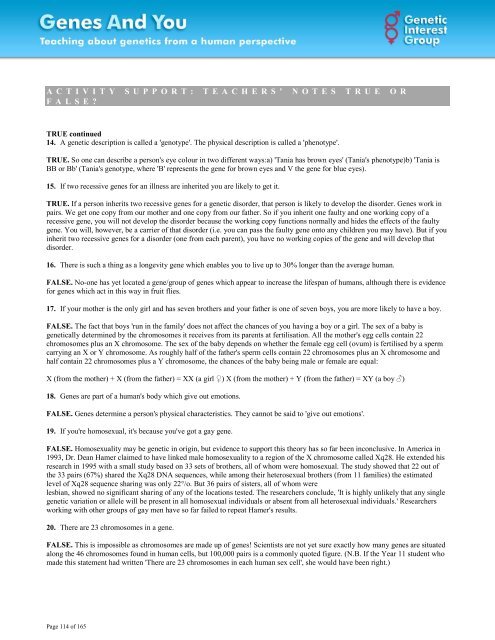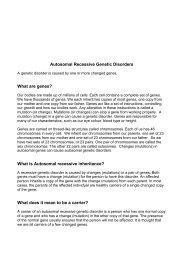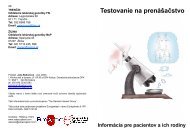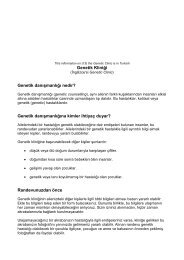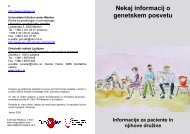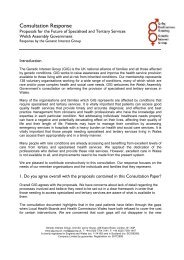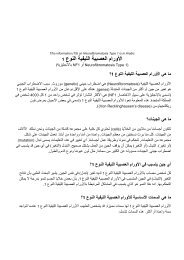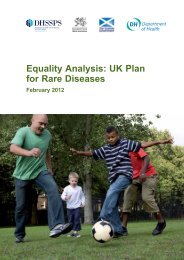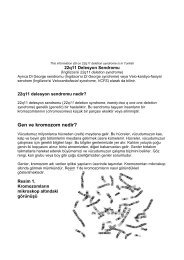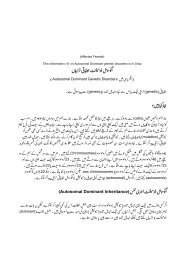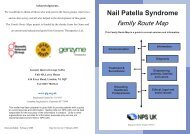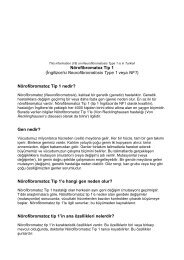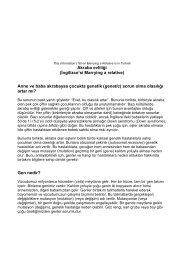TRUE OR FALSE? - Genetic Alliance UK
TRUE OR FALSE? - Genetic Alliance UK
TRUE OR FALSE? - Genetic Alliance UK
Create successful ePaper yourself
Turn your PDF publications into a flip-book with our unique Google optimized e-Paper software.
A C T I V I T Y S U P P O R T : T E A C H E R S ’ N O T E S T R U E O R<br />
F A L S E ?<br />
<strong>TRUE</strong> continued<br />
14. A genetic description is called a 'genotype'. The physical description is called a 'phenotype'.<br />
<strong>TRUE</strong>. So one can describe a person's eye colour in two different ways:a) 'Tania has brown eyes' (Tania's phenotype)b) 'Tania is<br />
BB or Bb' (Tania's genotype, where 'B' represents the gene for brown eyes and V the gene for blue eyes).<br />
15. If two recessive genes for an illness are inherited you are likely to get it.<br />
<strong>TRUE</strong>. If a person inherits two recessive genes for a genetic disorder, that person is likely to develop the disorder. Genes work in<br />
pairs. We get one copy from our mother and one copy from our father. So if you inherit one faulty and one working copy of a<br />
recessive gene, you will not develop the disorder because the working copy functions normally and hides the effects of the faulty<br />
gene. You will, however, be a carrier of that disorder (i.e. you can pass the faulty gene onto any children you may have). But if you<br />
inherit two recessive genes for a disorder (one from each parent), you have no working copies of the gene and will develop that<br />
disorder.<br />
16. There is such a thing as a longevity gene which enables you to live up to 30% longer than the average human.<br />
<strong>FALSE</strong>. No-one has yet located a gene/group of genes which appear to increase the lifespan of humans, although there is evidence<br />
for genes which act in this way in fruit flies.<br />
17. If your mother is the only girl and has seven brothers and your father is one of seven boys, you are more likely to have a boy.<br />
<strong>FALSE</strong>. The fact that boys 'run in the family' does not affect the chances of you having a boy or a girl. The sex of a baby is<br />
genetically determined by the chromosomes it receives from its parents at fertilisation. All the mother's egg cells contain 22<br />
chromosomes plus an X chromosome. The sex of the baby depends on whether the female egg cell (ovum) is fertilised by a sperm<br />
carrying an X or Y chromosome. As roughly half of the father's sperm cells contain 22 chromosomes plus an X chromosome and<br />
half contain 22 chromosomes plus a Y chromosome, the chances of the baby being male or female are equal:<br />
X (from the mother) + X (from the father) = XX (a girl ♀) X (from the mother) + Y (from the father) = XY (a boy ♂)<br />
18. Genes are part of a human's body which give out emotions.<br />
<strong>FALSE</strong>. Genes determine a person's physical characteristics. They cannot be said to 'give out emotions'.<br />
19. If you're homosexual, it's because you've got a gay gene.<br />
<strong>FALSE</strong>. Homosexuality may be genetic in origin, but evidence to support this theory has so far been inconclusive. In America in<br />
1993, Dr. Dean Hamer claimed to have linked male homosexuality to a region of the X chromosome called Xq28. He extended his<br />
research in 1995 with a small study based on 33 sets of brothers, all of whom were homosexual. The study showed that 22 out of<br />
the 33 pairs (67%) shared the Xq28 DNA sequences, while among their heterosexual brothers (from 11 families) the estimated<br />
level of Xq28 sequence sharing was only 22°/o. But 36 pairs of sisters, all of whom were<br />
lesbian, showed no significant sharing of any of the locations tested. The researchers conclude, 'It is highly unlikely that any single<br />
genetic variation or allele will be present in all homosexual individuals or absent from all heterosexual individuals.' Researchers<br />
working with other groups of gay men have so far failed to repeat Hamer's results.<br />
20. There are 23 chromosomes in a gene.<br />
<strong>FALSE</strong>. This is impossible as chromosomes are made up of genes! Scientists are not yet sure exactly how many genes are situated<br />
along the 46 chromosomes found in human cells, but 100,000 pairs is a commonly quoted figure. (N.B. If the Year 11 student who<br />
made this statement had written 'There are 23 chromosomes in each human sex cell', she would have been right.)<br />
Page 114 of 165


